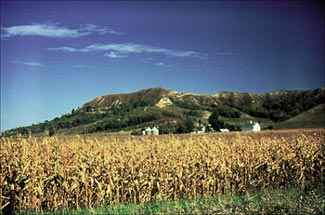
The steeply ridged bluffs of the Loess Hills' Murray Hill rise abruptly from the agricultural fields of Iowa. Photo courtesy of the Geological Survey Bureau, Iowa Department of Natural Resources.


Many Americans think of Iowa as having little topographic variation. However, in westernmost Iowa the Loess Hills rise 200 feet above the flat plains forming a narrow band running north-south 200 miles along the Missouri River. The steep angles and sharp bluffs on the western side of the Loess Hills are in sharp contrast to the flat rectangular cropfields of the Missouri River flood plain. From the east, gently rolling hills blend into steep ridges.
Loess (pronounced "luss"), is German for loose or crumbly. It is a gritty, lightweight, porous material composed of tightly packed grains of quartz, feldspar, mica, and other minerals. Loess is the source of most of our Nation's rich agricultural soils and is common in the U.S. and around the world. However, Iowa's Loess Hills are unusual because the layers of loess are extraordinarily thick, as much as 200 feet in some places. The extreme thickness of the loess layers and the intricately carved terrain of the Loess Hills make them a rare geologic feature. Shaanxi, China, is the only other location where loess layers are as deep and extensive. Though much older (2.5 million years) and much thicker (nearly 300 feet) than Iowa's loess, the Shaanxi loess hills have been greatly altered by both natural and human activity and no longer retain their original characteristics.

The steeply ridged bluffs of the Loess Hills' Murray Hill rise abruptly from the agricultural fields of Iowa. Photo courtesy of the Geological Survey Bureau, Iowa Department of Natural Resources. |
During the winters the meltwaters would recede, leaving the mud flats exposed. As they dried, fine-grained mud material called silt was picked up and carried by strong winds. These large dust clouds were moved eastward by prevailing westerly winds and were redeposited over broad areas. Heavier, coarser silt, deposited closest to its Missouri River flood plain source, formed sharp, high bluffs on the western margin of the Loess Hills. Finer, lighter silt, deposited farther east, created gently sloping hills on the eastern margin. This process repeated for thousands of years, building layer upon layer until the loess reached thicknesses of 60 feet or more and became the dominant feature of the terrain.
Clues in the loess layers help geologists determine the rate at which the loess was deposited. For example, ripples mean accumulation took place very quickly. Thin dark bands in the loess indicate the presence of soil and vegetation which means little or no deposition was occurring. Erosion has exposed other geologic formations beneath the loess, such as glacial deposits of sand and gravel and much-older limestone rocks. A 15-inch layer of volcanic ash can be seen in some road cuts, the result of eruptions at now-extinct volcanoes near Yellowstone National Park in Wyoming more than 710,000 years ago. Areas of solid bedrock can be observed in deep quarries along the western edge of the Loess Hills.
The pie-crust shapes of these hills are the result of extreme erodibility of loess by wind, water, gravity-induced slipping, and human activity. When dry, loess particles form stable surfaces. Wet loess, however, is very susceptible to collapse and erosion because of a lack of clay particles which normally bond wet soils together.
|
|
Erosion has sculpted the Loess Hills into unusual shapes. The irregular ridge crests are called peaks and saddles because they resemble an animal's back. Distinctive staircases-like features on the slopes of some hills are known as catsteps and are actually the result of slipping soil.
Gullies, although a natural part of this landscape, are a serious problem. They can be many miles long, more than 100 feet wide, and as deep as 80 feet. Bridges and roads collapse as the gullies widen, restricting farmers' access to their fields.
Human activities such as farming and mining can exacerbate erosion. Today, farmers practice terracing and contour farming in an effort to limit erosion.
The Loess Hills are home to several endangered plant and animal species. The uniqueness of the landscape and biota led to recognition of portions of the Loess Hills as a National Natural Landmark in 1986 by the U.S. Department of the Interior.

The valley floor at the base of the Loess Hills is deeply sliced by steep-sided gullies such as this one. Photo courtesy of the Geological Survey Bureau, Iowa Department of Natural Resources. |
|
U.S. Department of the Interior U.S. Geological Survey |
Information Handout July 1999 |